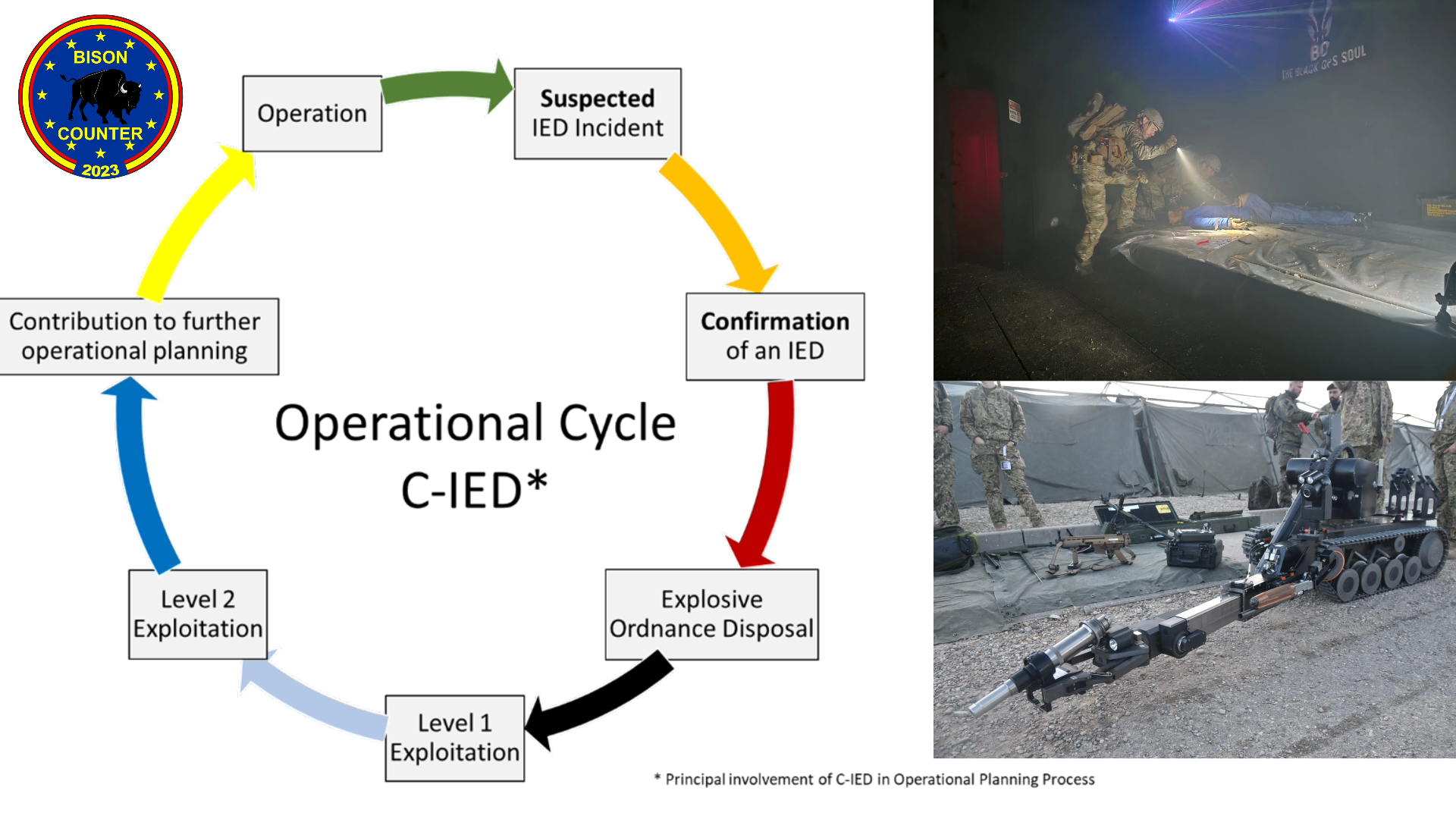Bison Counter 2023 (BC23), the largest European exercise to combat improvised explosive devices (IEDs), concludes in Spain after 12 intense days of joint training. The exercise, hosted by the Spanish Armed Forces, mobilized more than 1,000 personnel from 16 countries, either actively in different trainings or as observers. More than 270 scenarios were conducted between the two exercise sites.
The objective of the BC23 exercise was to train the full spectrum of the Counter-IED concept in a multi-level domain from tactical to operational. The exercise also took a multi-domain approach with land and maritime deployments across two locations, Cartagena and Zaragoza, including;
• Explosive Ordnance Disposal (EOD),
• Military Working Dogs (K9),
• Underwater Work (UW),
• Route Clearance Package (RCP),
• Weapons Intelligence Team (WIT),
• European Centre of Manual Neutralization Capabilities (ECMAN)
• Joint Deployable Laboratory for Exploitation and Analysis (JDEAL)
To achieve the highest level of full-spectrum C-IED training, role players and more than 300 vehicles were employed, including Centaurs from the Spanish 11 Cavalry Regiment, RG-31s, Huskies, armored JCBs, VAMTACs, Mk5s and Infantry Piranhas, to name a few. During the live exercise all tasks were observed to provide an after-action review as baseline for the lessons identified / lessons learned (LI/LL) process. Beginning next year, BC23 will be completed by a workshop reviewing the complete exercise, the observed LI/LL and a handover from Spain to the host nation for Bison Counter 2025, the Netherlands.
BC23 - full -spectrum, multilevel and multidomain
BC23 C-IED concept is based on a full -spectrum, multilevel and multidomain approach, integrating the intelligence cycle which allows interconnection among all levels. Figure 1 and the following assignment of the C-IED enabler illustrates the understanding of this.

Assuming that during an operation an IED was suspected by the involved forces. This suspected IED can be confirmed in various ways, including Route Clearance (RC), usage of Military Working Dogs (K9) and Underwater Work (UW), capabilities that were amongst others also practiced within the EDA Program Military Search Capability Building (MSCB ).
Once the IED is confirmed the (C-IED) Task Force decides how to eliminate this threat. The common approach is tasking Explosive Ordnance Disposal (EOD). But there are situations where the use of EOD may be inappropriate or the risk of exploding a device is unacceptable (i.e., direct threat to human life, critical effect on the mission, recovery of an intact device is of interest for exploitation, combination with CBRN payload). Therefore, manual neutralization is required. This highest level of skill and training can be achieved by courses delivered under the EDA program: European Centre of Manual Neutralization Capabilities (ECMAN).
After eliminating the threat, collection of evidence for further investigation is attempted. This is usually done by a Weapon Intelligence Team (WIT) or similar capabilities (Level 1 exploitation). The collected evidence is forwarded for Level 2 Exploitation, a capability provided by another EDA program, the Joint Deployable Laboratory for Exploitation and Analysis (JDEAL). The results provide information on enemy techniques, tactics and procedures (TTP), which can be used in further operational planning and thus contribute directly to the preparation of forces (PtF).
16 countries – together
BC23 brought together personnel from 16 countries: Spain, Austria, Belgium, Czech Republic, Finland, France, Germany, Hungary, Italy, Netherlands, Portugal and Slovenia participated actively.; Tthe United States, Latvia, Romania and Sweden participated as Observer countries. Luxembourg and Norway are also member countries of the
BISON COUNTER EXERCISES project, although they did not participate with troops in BC23.